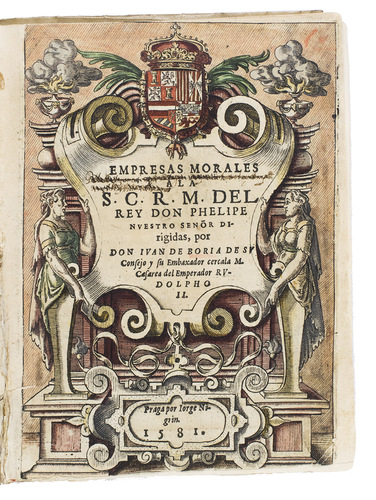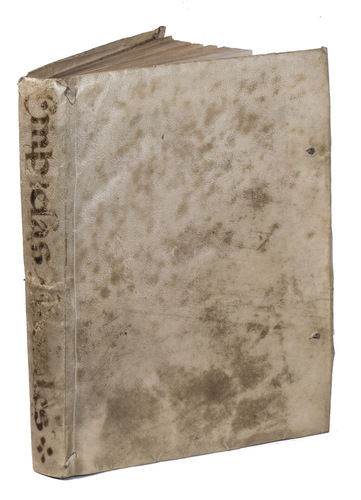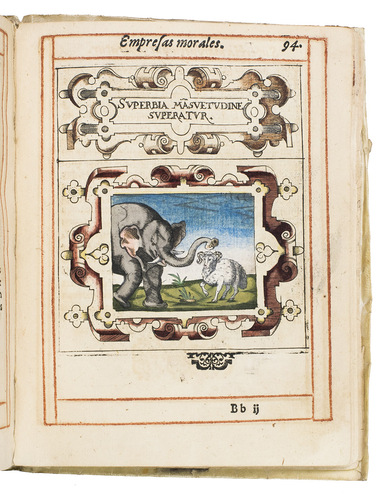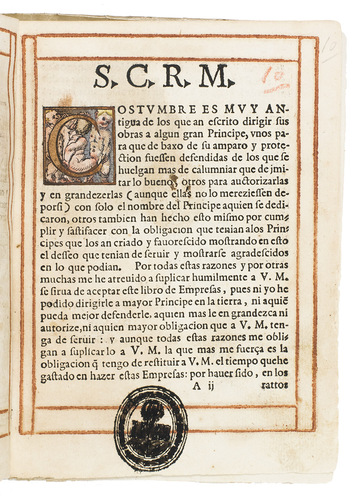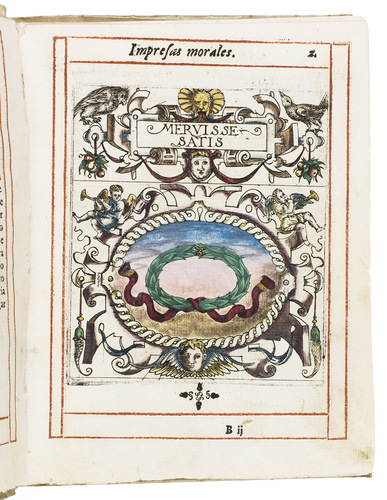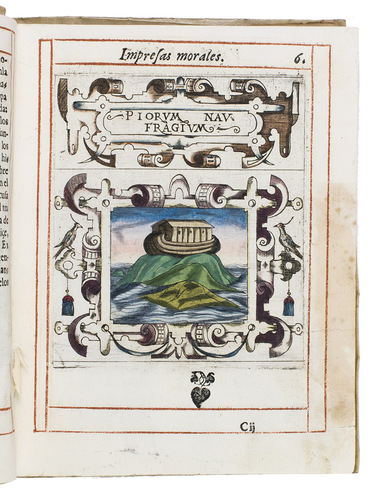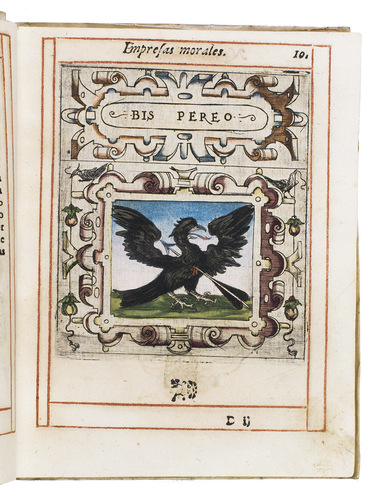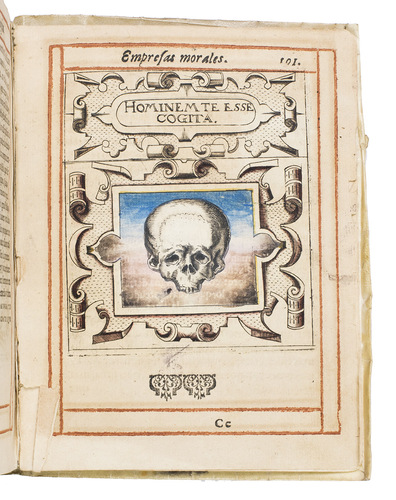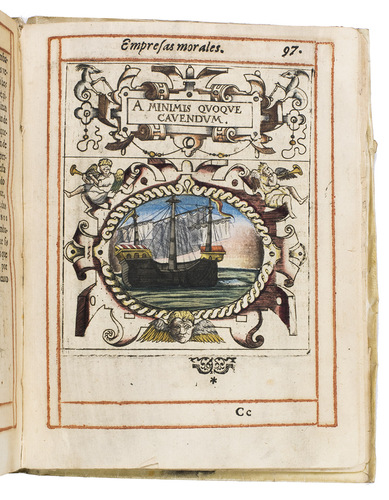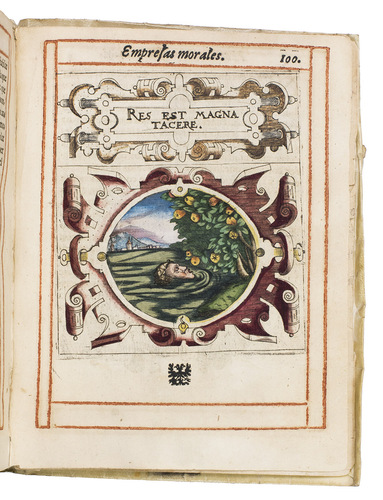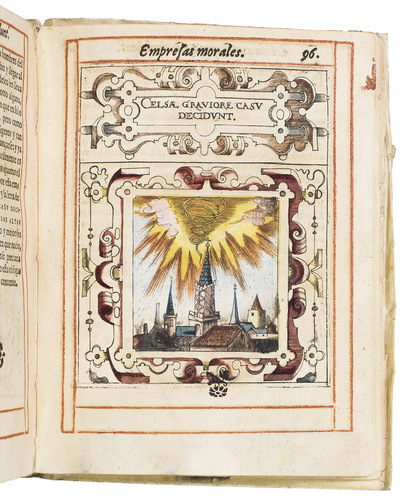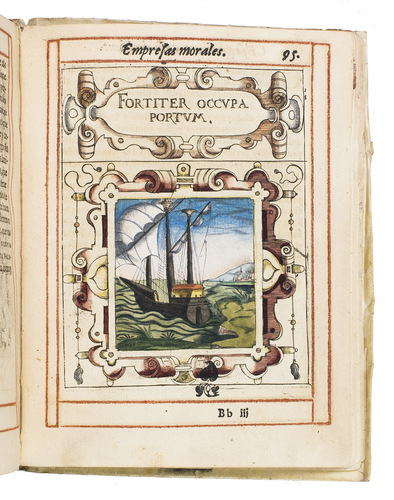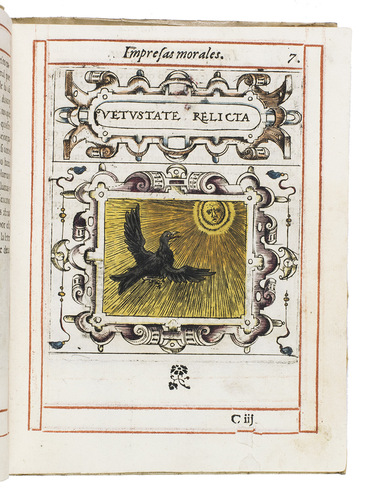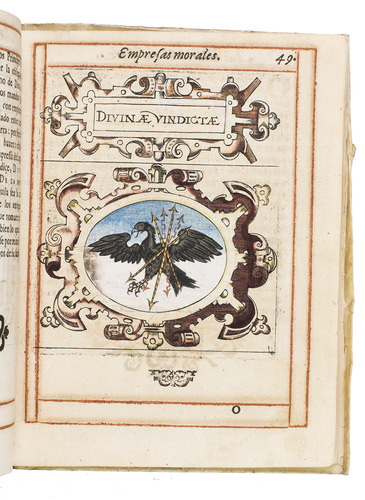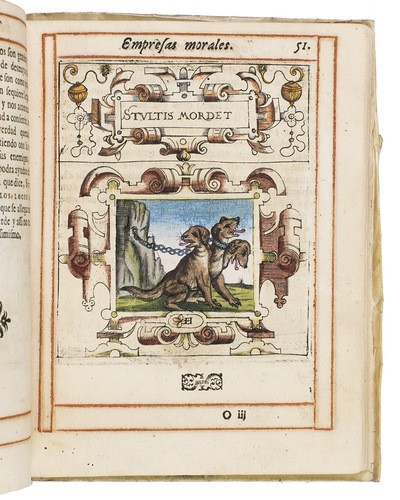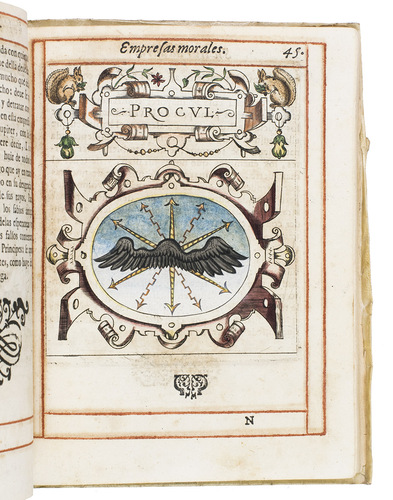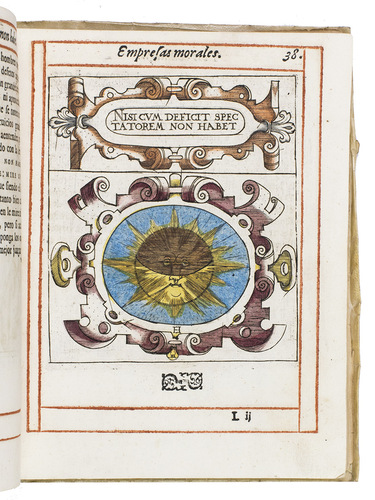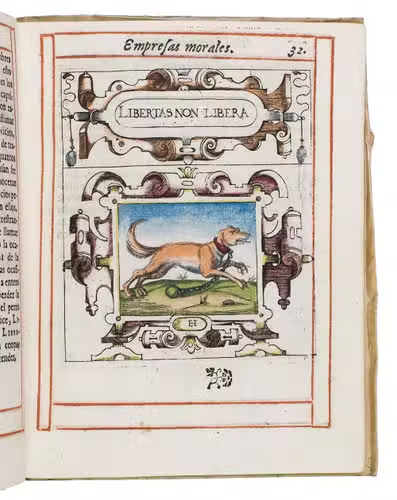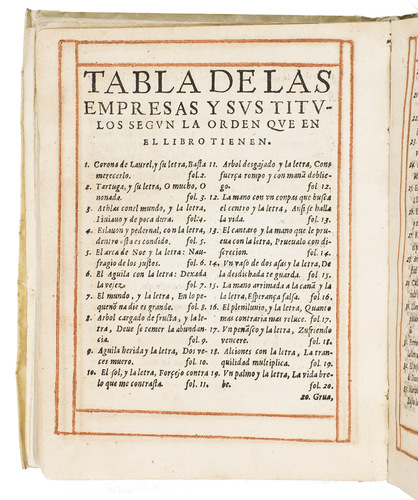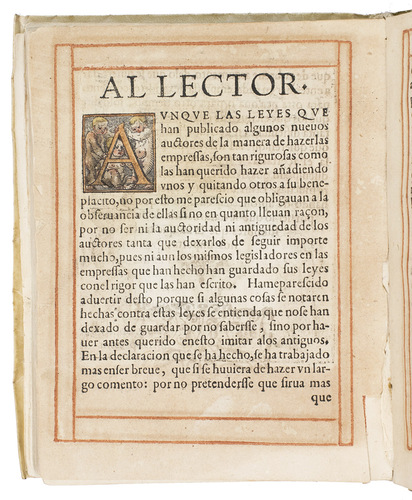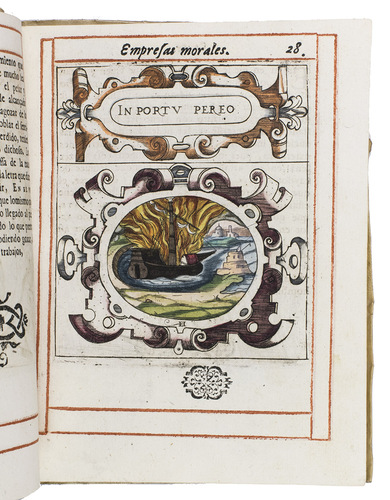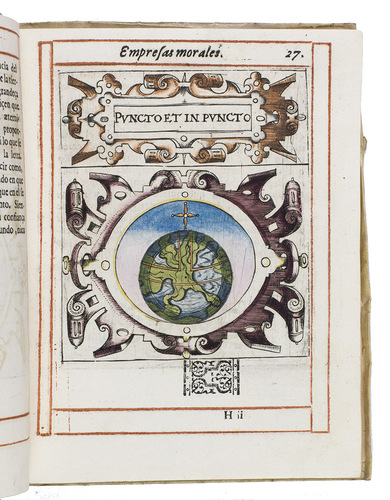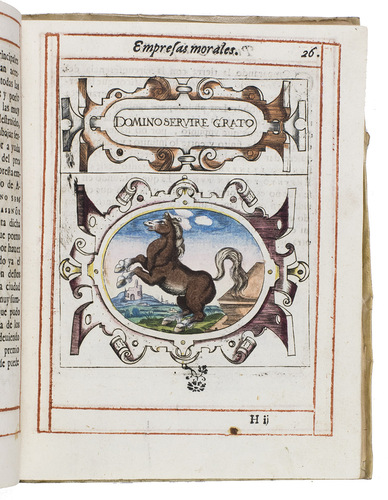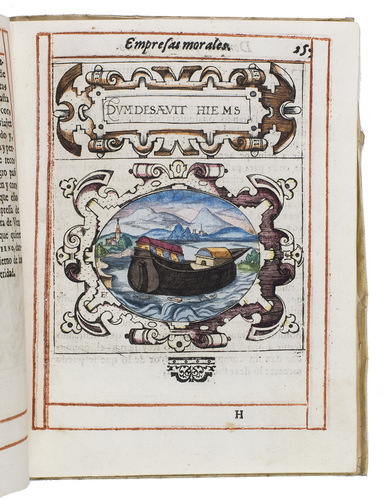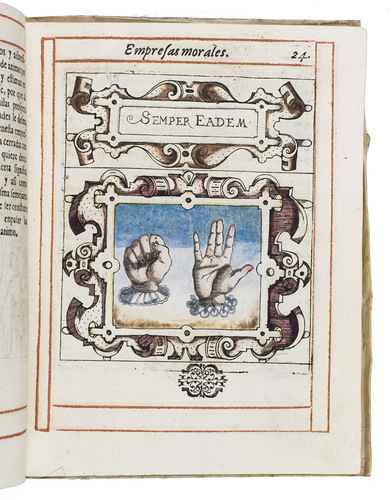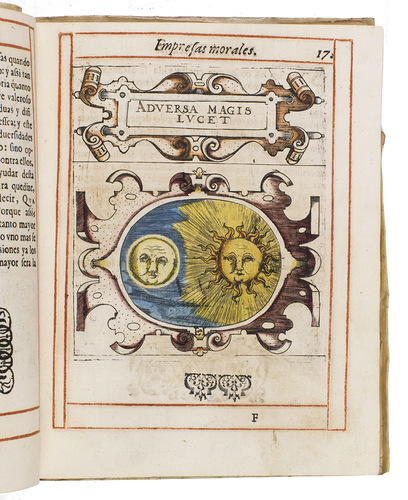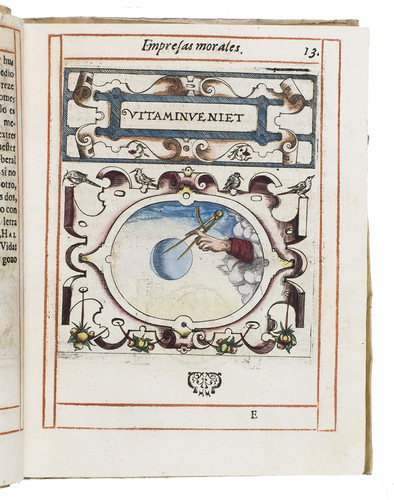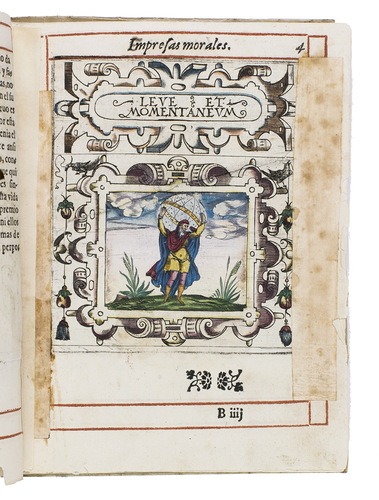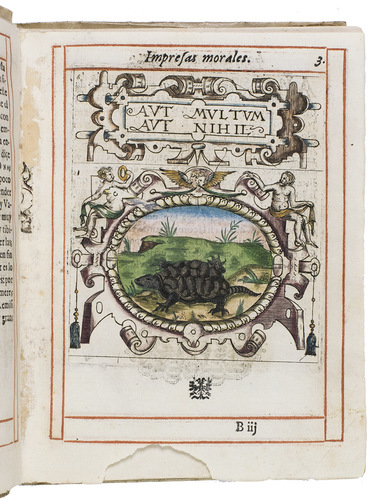BORJA, Juan de.
Empresas morales ...
Prague, Georg Nigrin, 1581. 4to (17.8 x 13.6 cm). With a hand-coloured engraved title-page, incorporating the coat of arms of the dedicatee King Philip II of Spain, 100 hand-coloured engraved emblems, 2 hand-coloured woodcut decorated initials, and numerous woodcut ornamental tail-pieces throughout, all text and illustrations are set within a frame of double red lines. Contemporary overlapping limp vellum with the manuscript title on the spine and remnants of ties. [2], 101, [3] ll.
€ 49,500
Very rare first edition of the first emblem book, written and compiled by a Spanish author in Spanish with Latin mottos, the first work of this kind to be printed in Bohemia. Juan de Borja y Castro (1533-1606) was a Spanish noble from the renowned House of Borja (Borgia) and was the third son of Saint Francis Borgia, or Francisco de Borja, fourth Duke of Gandía (1510-1572). He was educated by and among Jesuits at the Universidad de Gandía. He was a member of the religious and military Order of Santiago - at that time under the direct control of the Spanish monarchy - and later entered the service of King Philip II of Spain and Prince Carlos. As a soldier, he took part in the Italian Wars (a series of conflicts between 1494-1559). Borja was a distinguished diplomat, first acting as a substitute for the Portuguese ambassador and in 1576 moving to Prague as the Spanish ambassador to Emperor Rudolph II of the Holy Roman Empire, where he stayed until 1581. Upon his return to Spain, he was named head "majordomo" of Maria de Austria, acting as the head of her household staff until 1603. The Empresas morales is Juan de Borja's only known literary work. A second edition was published in Brussels in 1680 by Borja's grandson, Francisco, who added 124 emblems claimed to have come from among the original authors papers. At the end of the 17th century, in 1697, a Latin translation by Ludovicus Camerarius was published in Berlin, while a German translation by Georg Friedrich Scharff had appeared a few years earlier (1693), also in Berlin.
The present copy contains only one cancel engraving on leaf 91, instead of the 8 cancels noted by Landwehr in the Glasgow University copy and instead of the 6 different cancels noted in the description of the Getty Research Institute copy.
Lubomír Koneèný attributed the engraved title and one hundred engraved emblems to Erasmus Hornick, an artist born in Antwerp in 1520, who worked in Augsburg and Nuremberg as a printmaker, designer, and goldsmith. In 1582, Hornick was appointed "Camer Goldschmidt" (royal (or imperial) goldsmith) by Emperor Rudolf II in Prague. Hornick is known for five series of etchings of jewellery, vases, and metal work, some bearing the monogram EH, and numerous unsigned drawings (no silver- or goldsmith work bearing Hornicks mark survives). Subsequently, Silke Reiter conducted a more thorough examination of the monograms featured on 41 plates in the Empresas morales, identifying three types and interpreting them as the initials EI of an unidentified printmaker. He found no stylistic similarities with Hornick's drawings.
The name of the printmaker notwithstanding, the emblems in this very rare first edition of the first Spanish emblem book remain remarkable, especially these hand-coloured examples in the present work.
With the small bookplate of Arthur & Charlotte Vershbow on the front pastedown, a crossed out (owner's?) inscription on the engraved title-page and a crossed out IHS stamp on ll. A1r, A2r, and 1r (= B1r). The vellum binding is slightly dust soiled and the manuscript title on the spine is slightly faded. The first blank flyleaf is missing, the gutter between the front paste-down and the engraved title-page is fragile, leaves 1 and 101 are nearly detached, the gutters of leaves B3-4 and B4-C1 are reinforced, and some leaves are restored/reinforced in the margins without affecting the text. Leaves 3 and 84 show a hole in the centre of the leaf, affecting text and image and leaf 80 shows a large horizontal tear in head margin, slightly affecting the red frame, otherwise with some small tears in the margins of several leaves, barely affecting the text. Slight browning throughout, mainly to the first few leaves and the last 2/3rds of the work, and leaf 91 contains a cancelled illustration, with its correction mounted over it. Overall a remarkable copy of the very rare first Spanish emblem book, in contemporary colouring. Antonio, Bibliotheca Hispania nova, vol. 1 (1783) p. 663; Becker, Fact and Fantasy, Illustrated Books from a Private Collection (Cambridge, MA 1976), no. 41 (this copy); Henkel-Schöne (1976) p. CLXXXI; Iberian Books 2168 (3 copies); Landwehr, French, Italian, Spanish and Portuguese emblem books, 172; Palau 33112 ("primera edicion rara"); Praz p. 281; USTC 342746 (3 copies, same as IB); WorldCat 434061521, 181666513, 21936852 (5 copies); cf. Koneèný, "La ilustración de las Empresas morales de Juan de Borja: Erasmo Hornick," in Ars Longa: Cuadernos de Arte 3 [1992], pp. 9-12; Reiter, Erasmus Hornick: ein Goldschmied, Radierer und Zeichner des 16. Jahrhunderts [Regensburg, 2012], pp. 72-77
Related Subjects:





























